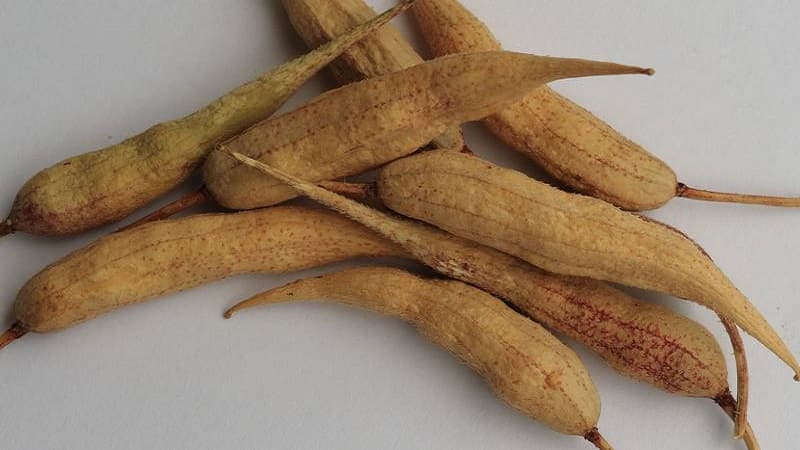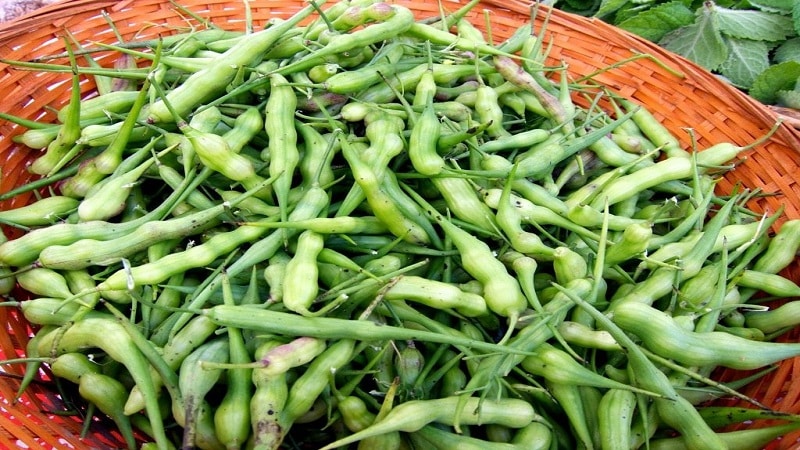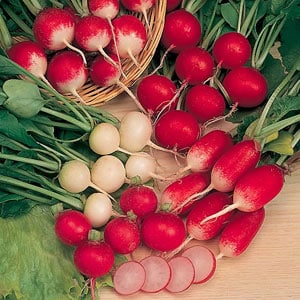How to collect radish seeds at home: step-by-step instructions and useful tips
How great it is to crunch on fresh radishes from the garden after a long, cold winter! But sometimes it happens that the purchased seeds grow into roots that are not at all what the photo on the colorful packaging promises. To avoid disappointment, grow the seeds of your proven favorite varieties yourself.
This is not difficult to do if you know the rules and secrets that we will talk about in the article.
How to properly grow radishes for seeds
Radishes are an annual or biennial plant of the cabbage family. Annual varieties are more common.
After the root crop has fully ripened, a branched flowering shoot develops from the leaf rosette, reaching a height of 25-100 cm. Small, white flowers with a pinkish or purple tint appear 50-70 days after sowing the seeds, flowering lasts 30-35 days. In place of the flowers, pods up to 7 cm long are formed, containing about a dozen light brown rounded grains.
Important! Radishes are cross-pollinating plants. To obtain seed material with characteristic varietal properties, the root crop must be planted away from other cabbages, especially radishes.
Spatial isolation must be at least 200 m. If the size of the site does not allow such a distance to be maintained, the beds with plants are surrounded by tall crops.
Radishes are grown for seeds in two ways: direct and transplanted. Each of them has advantages and disadvantages.

Direct way
The advantage of the method is its simplicity. The radishes are left in the place where the grains were sown. During the fruiting period, the plant throws out flowering stems on which seeds are formed.
The direct method is rarely used due to the following disadvantages:
- long ripening of seeds (up to 5 months);
- risk of cross-pollination with other varieties;
- It is impossible to carry out a high-quality selection of mother plants.
This is interesting:
Review of the best radish varieties for open ground and greenhouses.
What vitamins are in radishes and how are they good for health?
Transfer method
A minor inconvenience of the transplant method is that it is labor intensive. Ripe root crops are dug up and the strongest, smoothest, and most suitable varieties are selected. After this, the foliage is cut off, leaving cuttings approximately 3 cm long. The root is shortened to 4 cm and planted in a previously prepared place. The distance between plants is left at least 40 cm. When planting, it is not allowed to sprinkle the leafy rosette with soil.
Attention! The selection and transplantation of root crops is carried out on the same day, otherwise the plants will dry out.
Advantages of the technique:
- accelerated seed ripening (up to 120 days);
- selection of the best mother plants;
- the ability to isolate bushes from other varieties.
Features of care
Seed radishes are regularly weeded and watered. Periodically inspect the plants for the presence of pests: aphids, cruciferous flea beetles and others. If necessary, treat with insecticides depending on the type of pest.
As they grow, the flower stalks are tied to pegs.
Suitable varieties
Any variety you like is suitable for collecting seeds. To obtain seed at home, pure-grade plants are used, the distinctive characteristics of which are genetically fixed.
Seeds are not collected from hybrids. The offspring obtained from a hybrid radish will be heterogeneous, splitting according to characteristics will occur and it will not be possible to obtain a predictable result.
Timing for collecting planting material
The seeds are completely ready 65-70 days after the radish blooms. Depending on the time and method of planting, seed collection begins at the beginning or end of September. The criterion for ripeness is a change in the color of the pods from green to light yellow or light brown.
The shoots with pods are cut, tied into a bundle and dried for about two weeks in a dry, well-ventilated room (attic, barn, glazed balcony or loggia).
How to collect radish seeds at home
Well-dried and suitable for further processing, the pods crumble easily if you pick them up and crush them.

Step-by-step instructions for extracting seeds
It is easy to extract seeds from fruits:
- Use pruning shears to separate the pods from the stems.
- In a suitable container, crush the pods and the remains of small stems so that all the fruits open and the grains spill out.
- Pour the resulting mass with water for 10-15 minutes. Pulp, small stems, empty seeds will float up. Benign seed will remain at the bottom of the container.
- Throw the trash on the compost heap. Rinse the remaining grains with water 2-3 times and spread in an even layer on a plate to dry.
The yield of seeds from one plant is on average 20 g (or about 5 standard purchased bags).
Seed treatment
After drying, the remaining pods and small debris are removed using a fan. It is better to carry out the procedure outdoors or in a barn. For final cleaning of the seeds, spread a cloth and spill the material through a stream of air.Dry plant residues will fly away, full-fledged seeds will fall onto the fabric.
After air cleaning, the planting material can be calibrated by choosing large seeds that are similar in size.
Where and how to store
Cleaned and sorted grains are placed in a paper bag, fabric or canvas bag. The main thing is that the material must be breathable.
Attention! Do not pour the seeds into the container too tightly, leave enough free space.
The packages are labeled with the name of the variety and the date of collection. Store seed in a dark, cool and dry place. Radishes remain viable for up to 7 years.
Useful tips

A few tips from experienced gardeners will be useful for successfully obtaining homemade seeds of your favorite radish variety.
- Before transplanting, it is useful to dip the root crops of the selected mother plants into a mash prepared from cow dung and clay in a 1:1 ratio with the addition of water until it reaches a creamy consistency. This measure protects the plants from drying out and stimulates the germination of new roots.
- At the beginning of the ripening of the pods, the plot with seed plants is covered with non-woven material to protect it from being eaten by birds.
Read also:
The benefits and harms of radishes for the human body.
Top 8 best pickled radish recipes for the winter.
Preparing radishes for the winter: simple and tasty recipes for healthy snacks.
Conclusion
There are no difficulties in growing homemade radish seeds of your favorite varieties. After the root crops are ripe, the plant produces flowering shoots, on which fruit pods with grains are formed.
Knowing the specifics of obtaining seed material and adhering to simple rules, you can easily obtain pods with grains. This will eliminate unwanted surprises during subsequent plantings.With proper collection and storage, loss of viability of radish seeds occurs no earlier than after 7 years.